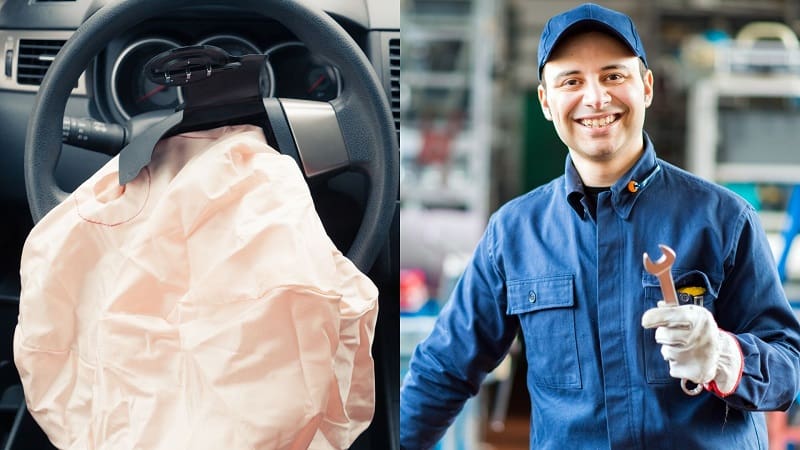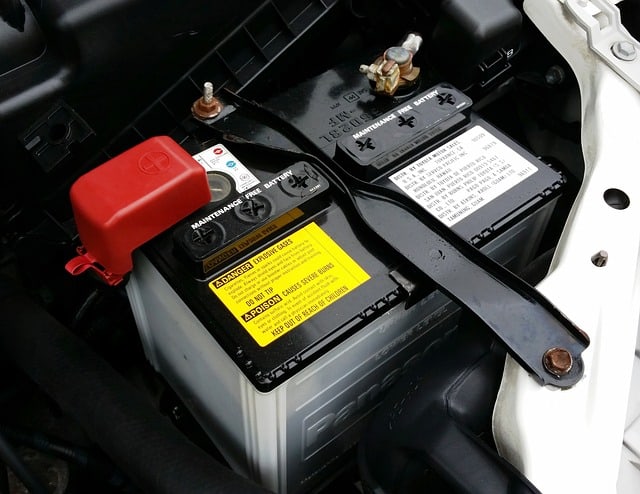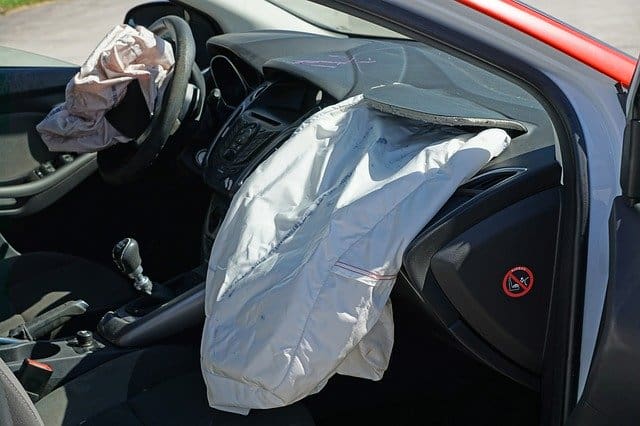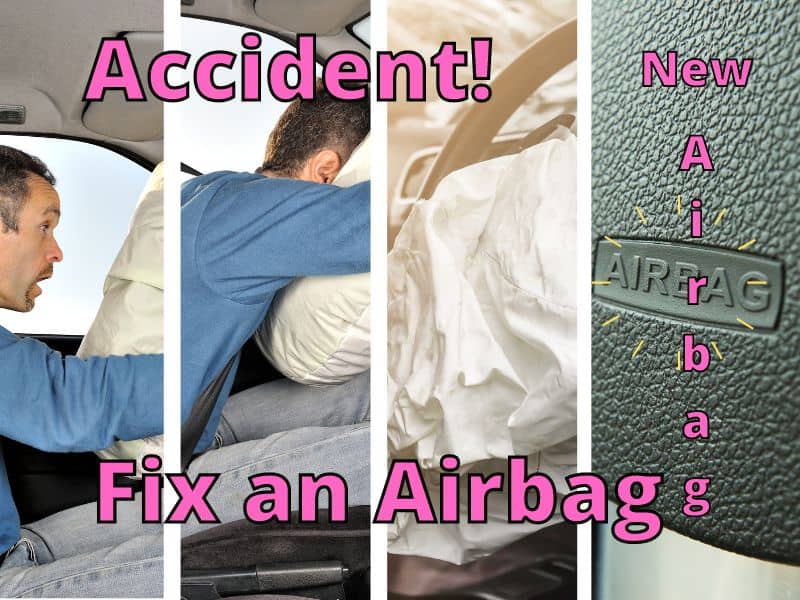Airbags are an incredibly important safety feature in your car to keep you safe in the event of a collision. You’ve likely seen videos of an airbag being deployed during an accident, protecting the driver and front passenger. While many are familiar with airbags and their ability to deploy, you may also be wondering what happens to them after the accident occurs.
After an accident occurs, airbags are fixed by resetting the sensors and replacing the airbag unit. Most modern vehicles will not allow you to reset an airbag for safety precautions; instead, you must replace it entirely. This requires removing the old airbag from the driver or passenger side and installing a new one.
Replacing an airbag after it is deployed in an accident is incredibly important before attempting to drive your vehicle again. This will ensure that the airbag will work properly if another accident occurs. We will look at the best ways to fix an airbag after an accident so you can safely return to the road.
Why Airbags Cannot Be Reused After an Accident?
Technology in older cars allowed you to reuse airbags but place them back into their compartments. This could be incredibly dangerous and not redeployed properly when another accident occurs. To avoid these dangers, almost all newer cars will require an airbag to be replaced entirely.
The technology used in today’s airbags is the primary reason they cannot be reused after an accident. It’s important to understand how an airbag works to explain this principle. Airbags are condensed into small compartments in the car and are released by the triggering of sensors based on collision force. The bags inflate quickly through a chemical reaction.
Sodium azide and potassium nitrate react to form nitrogen gas, which is responsible for inflating the airbags quickly. Because these compounds are all used up after the airbag deploys, you can’t reuse the same bags. You will need to get new ones that have these chemicals ready to react when triggered in a future accident.
Car manufacturers do this intentionally so that you have to replace the bags to ensure the highest safety standards. Even if bags could be reused, there are risks associated with being reset improperly or a lack of sensor triggering. If the entire mechanism needs to be replaced, you don’t run into as many safety risks, knowing the new airbag will do its job if needed.
How to Fix Airbags After an Accident?
It is necessary to get your airbags fixed before attempting to drive your vehicle. Without airbags, you leave yourself and others in the vehicle defenseless in a collision. The steps to fixing an airbag will vary slightly based on their location, but they all apply similar principles.
These are the steps to fixing an airbag after an accident:
- Seek Professional Help for Replacement
- Detach Battery Cable
- Remove Bolts and Paneling
- Disconnect Airbag Wiring
- Take Out Used Airbag
- Replace with Identical Airbag
- Reattach Wires and Screws
- Reset Airbag Sensors
If you have been in an accident and are looking to fix your airbags, we recommend step #1 on your own and then letting the pros take care of the rest. Making sure the airbags are removed and installed correctly is incredibly important to avoid future malfunctions. While you may want to do it yourself because of expenses, professional replacement is the safest option.
We have detailed all the steps to fix an airbag after an accident so you can understand how it works and the detail that is necessary to return your vehicle to safe and running conditions.
Seek Professional Help for Replacement

It is recommended that a vehicle is taken to a body shop or auto repair immediately after an accident occurs. You will want to have your airbags replaced before you drive your car again to ensure you are prepared for any future collisions. An auto repair will be able to give you an estimate on the cost of the repair.
If you are unsatisfied with the quote, you can get a quote from multiple auto repairs. Look for companies that have good reviews so you know that the work they will be doing is of high quality. Unlike cosmetic issues with a car, replacing the airbags safely and correctly is absolutely necessary.
Attempting to replace an airbag yourself can be very dangerous, especially if you do not have any prior experience doing so. Airbags have successfully saved thousands of lives, and those are all due to proper installation. The National Highway Traffic Safety Administration encourages car owners to only work with authorized service centers to fix airbags.
Detach Battery Cable

Before any attempts at removing the airbag occur, it is necessary to unplug the negative terminal on the car battery. The airbag is connected through electrical wiring, and any interference with a car plugged in could result in injury or electrocution. By detaching the negative battery cable, power is no longer flowing through the car.
After unplugging, the battery needs to train (rest) for at least one hour. This will ensure that there is no backup power that could still be surging through the vehicle. It is best to wait a couple of hours to avoid any unnecessary accidents with unwanted battery power.
Remove Bolts and Paneling
The type and locations of bolts that hold your airbag will vary on the make and model of the car. User manuals will contain this information, and service centers will be familiar with this replacement knowledge. Airbags are required to be located in the front of all car models made after 1999. Airbags can be found in a wide variety of locations, including:
- Steering wheel: In some airbag deployments, you may need to replace the entire steering wheel or column. This will require more detailed installments, often best completed by a professional. Bolts are located on the backside of the steering wheel base.
- Passenger glove compartment: Removal of the glove compartment is needed to access the airbag underneath. These will deploy to protect the front seat passenger. Access to the bag is found inside the compartment with screws.
- Side doors: While not always required, many manufacturers are putting in side airbags for extra support and protection.
- Upper curtains: These are found on the roof paneling, where the rubberized door framing will need to be removed for access.
- Seat belts: Newer car models are experimenting with small airbags that deploy from the seatbelt, providing protection for all passengers throughout the car.
- Seats: Airbags will also deploy from the side of the seats to protect collisions coming from the side and to prevent passengers from colliding with one another. These bags often break through the seating material and will need to be completely replaced.
For the driver-side airbag, the keys will need to be placed in the ignition with the steering wheel turned so you can access the bolts behind. This will allow the front of the steering wheel to pop off and reveal the airbag underneath. Passenger airbags are found behind the glove compartment, which will need to be removed with the screws found inside.
The side airbags and those located in the roofing area will also have screws and bolts to remove the fabric or paneling that covers these interiors. Knowing where all these bolts are located is important for access as well as to not damage the panels upon removal.
Removing these bolts and screws gives the repair person access to the airbag connectors so they can remove the airbag safely.
Disconnect Airbag Wiring
The wiring that is connected to the airbag is very fragile and must be carefully removed for replacement. There are two connections on the driver’s side; you will need to carefully remove them, being aware that different car manufacturers will design these slightly differently. It is necessary to understand the specific model’s connector system before interfering.
These connectors are taken off with small tools or gently removed by pressing small teeth. Wiggling the connectors is not recommended, as this can damage the small pieces. Instead, the connectors should be removed by pulling away in a straight motion.
The wires need to be safely removed from the old airbag in order to replace it with a new one. If the wire connectors are damaged in the process, it will not be possible to safely reconnect a new unit. Both the teeth on the connector and the outlets on the airbag itself are made of fragile parts. Ensuring that these components are not damaged is incredibly important.
The wires will be kept out of the way so as not to interfere with them as the used airbag is being removed from the vehicle. Removing the connectors from the airbag must be done with extreme caution, especially if the airbag is never deployed. You should treat the device as a bomb that could easily explode or deploy if you are not very careful.
Take Out Used Airbag

Once the wires have been disconnected, the old airbag will be taken out of the vehicle. After an accident, it may also be required to remove airbags that were not deployed because they were faulty or did not engage as they should have. You have to be increasingly cautious in working with these airbags as they still have the possibility of deploying.
Remove all airbags carefully, separating those that have been deployed from those that have not. Follow these precautions when working with an undeployed airbag:
- Keep head and body away: If you can, try not to be in the direct line of contact with the airbag so that if it does deploy, you will avoid head and bodily injury.
- Face trim covering away from you: When carrying the airbag, make sure the trim cushion or covering is not facing you so it will deploy away from your body.
- Avoid high temperatures: Keep the airbag out of direct heat, which may trigger combustion.
These undeployed airbags cannot be disposed of as trash and must be handled carefully. When they are disposed of, they could explode or expose others to chemicals that are dangerous in isolation. Deployed airbags do not have any special instructions for disposal as they are harmless.
Undeployed airbags that are replaced will be sent to recycling centers that can safely dispose of the unit and its reactive materials.
Replace with Identical Airbag
Once the old airbag has been removed, the new airbag needs to be installed following the principles used to remove the old one. It is important that the new airbags are an identical match to the old ones, preferably using those made by the manufacturer, also known as OEM. This is the safest way to ensure that the parts will fit properly and work in the future.
Replacement airbags should be new and not used. This will ensure that they are properly equipped and will deploy when needed in the event of a future accident. Ensuring the airbag is new is a primary reason it is recommended to work with authorized service centers. These businesses are vetted and can be trusted to find proper replacement parts.
Airbags should be carefully put into their proper spots and facing the correct direction before any securing is done. It is important that the airbag is installed in the exact same manner as the original to make sure it will deploy correctly.
Reattach Wires and Screws
Now it is time to return the car back to its original working condition. Once the airbag is in place, you will start to work backward from the steps we just laid out. This means that the airbag will need to be reconnected to the wires, carefully making sure the teeth and fragile plastic pieces are secured tightly.
Once properly reconnected, paneling and screws can be replaced in their original locations. Once everything looks back to normal, you will want to look at resetting the airbag sensors. Properly securing all paneling is important for both the aesthetics of the vehicle, but also so the airbags can deploy properly in the future.
Airbags hit a specific part of the paneling and trim in a car, allowing the airbag to reach the passengers upon impact. If the parts are not replaced where they should be, the airbag may struggle to break through the material and do its job effectively.
Reset Airbag Sensors
Resetting the airbag sensors is crucial as it is responsible for allowing the airbags to deploy at all. When the car comes in contact with a foreign object, the sensors are triggered by the force of the impact. This allows the airbags to deploy and protect the passengers inside. After an accident, these sensors are no longer in position.
Once the airbags are properly replaced and the battery is turned back on, your sensors will be reset. Every car will have a different location for the airbag sensors. The user manual of a car will detail exactly where this sensor is located. Most cars will display a light showing that the airbag sensors need to be checked. If replaced properly, there should be no light.
Sometimes this airbag light will turn on even when there hasn’t been an accident. If this happens to you, try these steps before servicing the vehicle:
- Turn off battery: Similar to the process of replacement, you can unplug the car battery for a few minutes and then check once you replace the cables.
- Start and restart the car: If the light turns on and then off, turn the car off and wait a couple of seconds before restarting the car. Do this 2-3 times, and the light may go away completely.
- Service scanners: Many cars require that scanners are used by a manufacturer or service center to reset or fix airbag sensor problems. This is to prevent people from driving with potentially faulty airbags.
If none of these tips work, you may need to replace the airbag sensor entirely. You want it to work in the event that the airbags are faulty and need replacement before an accident occurs. Once these sensors have been put back into place with the replacement of the airbag, the battery will be reconnected, and the car can be driven again.
New Airbags After an Accident
When it comes to car safety, being overly prepared is critical. When airbags deploy after an accident, they prove how effective they are in keeping passengers safe. Fixing the airbags should be handled with the same amount of precaution, so they would be able to perform the same action again.
While no one wants airbags to have to deploy again (signifying a new accident), knowing that they will, if necessary, is imperative for user safety. Airbags should be fixed by authorized service centers and professionals to make sure that all of the proper steps are followed so that you can depend on them in the future!

